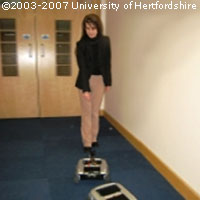EU project to develop emotionally aware robots
Designing emotionally aware robots which are able to interact with humans in everyday settings and develop emotionally in response to their owner's needs is the aim of a new EU-funded project. The FEELIX GROWING (FEEL, Interact, eXpress: a Global approach to development With Interdisciplinary Grounding) initiative brings together partners from fields as diverse as developmental and comparative psychology, neuroimagery, ethology and robotics. It is funded under the Sixth Framework Programme's thematic area for information society technologies (IST) to the tune of €2.5 million and will run for three and a half years. Robots have the potential to provide us with many important services, including company, care giving, entertainment, patient monitoring and therapy support. However, if robots are to become truly integrated into people's everyday lives, they need to be able to adapt to their environment. 'If robots are to live with people, instead of being taught everything, they should develop with their human users so that they can grow with them,' explained Lola Cañamero of the University of Hertfordshire's School of Computer Science, which is coordinating the project. 'For example, if the human bursts into tears, the robot will gradually learn whether it is better to try to comfort them or leave them alone.' The robots developed by the project will use cameras and sensors designed to detect parameters such as heat, touch and distance to pick up on non-verbal cues which provide information on a person's emotional state. For example, one area of focus will be the way people move. 'The way you walk can tell a lot about your emotional state,' Dr Cañamero told CORDIS News. Other indicators of emotional state include tone of voice and, of course, facial expressions, although getting robots to recognise the latter is extremely difficult. 'The light has to be stable and you have to put marks around the person's mouth and eyes,' explained Dr Cañamero. And although the robots will not be able to feel emotions the way we do, they will contain mechanisms which will enable them to appear to express emotions in response to their owner's behaviour. The robots will develop their behaviour based on the responses of the people they spend the most time with. Furthermore, they will be able to discriminate between individuals, for example different members of a household, and learn to respond to their different personalities appropriately. However, while the robots will have to learn how to interact with people, people will also have to get used to having a robot around and learn how to communicate with it and understand its limitations. Dr Cañamero's own experiences have shown that people adjust their behaviour for the robot automatically. For example, people quickly learn to adjust their walking pace to allow robots to keep up with them and help them around obstacles. As to the question of how ready people will be to welcome robots into their lives, Dr Cañamero notes that this is largely cultural. 'In some countries robots are already part of everyday life,' she said. 'In Japan even the elderly see robots as normal things to have.' Robots are used for therapeutic purposes in care centres for the elderly in Japan, where residents interact with the robots differently to how they would interact with an animal. In Europe young people are more willing to accept robots, but older people are more sceptical, although Dr Cañamero believes that this could change. 'What is changing is the fear that robots will replace us,' she notes. 'They are increasingly seen as tools that can work with us and for us.' Understanding these cultural differences in the acceptance of robots is an important part of the project, and to this end the FEELIX GROWING partners will work closely with scientists from the Massachusetts Institute of Technology in the US and the Communications Research Laboratory in Japan. By the time the project comes to an end in May 2010, the project partners hope to have two prototype robots ready which will have capabilities enabling them to work in the home and in a healthcare setting.

